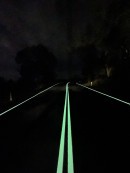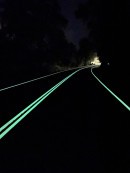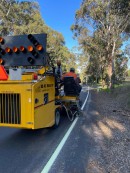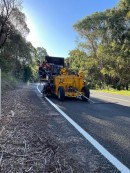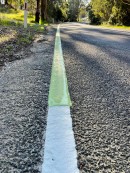People who drive at night surely know how difficult it is when the road markings are not visible. Usually, the markings are harder to follow in the dark because the paint has faded or the road was recently paved. The Australians have found that photoluminescent paint can help a great deal with boosting traffic safety.
Driving at night can be challenging, especially when weather conditions are less than optimal. In dense fog, for instance, seeing the road markings can be a lifesaver. That’s why unmarked roads are inherently more dangerous, even in ideal conditions. Australians have found a solution to making road markings more visible at night. They want to paint them in photoluminescent paint, similar to that used for the hands of tactical watches.
The paint will be applied on selected rods in the state of Victoria (Australia) as part of a road safety program by Regional Roads Victoria. The glow-in-the-dark road markings are one of the three treatments projected to be used as part of the state’s Innovative Package, which costs the taxpayers AUD$4 million (USD$2.82 million).
Tarmac Linemarkings is the company chosen to apply the photoluminescent paint alongside OmniGrip and Vic Roads, which will cover the other two treatments. In a recent Facebook post, Tarmac Linemarkings boasted the paint will be applied “all across Gippsland from Phillip Island to the border.”
The second treatment in the Innovative Package involves using road markings with higher reflectivity. This is achieved by adding thicker glass beads and thermoplastic to the paint. It does not make it glow like in the first case. Still, it assures better visibility when the headlights illuminate the dye in the dark.
Finally, the third measure uses LED tactile paving at controlled pedestrian crossings. The LEDs follow the colors of the traffic light for added visibility to pedestrians who, more often than not, have their eyes aiming low toward the phone screen.
However useful it may be, the glow-in-the-dark paint has not escaped criticism. Some are afraid it would be a money pit because it would need to be refreshed often. Others are afraid it could contain dangerous, radioactive materials. Some even consider it outright hazardous because people would want to turn off the headlights to see how cool it is.
The paint will be applied on selected rods in the state of Victoria (Australia) as part of a road safety program by Regional Roads Victoria. The glow-in-the-dark road markings are one of the three treatments projected to be used as part of the state’s Innovative Package, which costs the taxpayers AUD$4 million (USD$2.82 million).
Tarmac Linemarkings is the company chosen to apply the photoluminescent paint alongside OmniGrip and Vic Roads, which will cover the other two treatments. In a recent Facebook post, Tarmac Linemarkings boasted the paint will be applied “all across Gippsland from Phillip Island to the border.”
The second treatment in the Innovative Package involves using road markings with higher reflectivity. This is achieved by adding thicker glass beads and thermoplastic to the paint. It does not make it glow like in the first case. Still, it assures better visibility when the headlights illuminate the dye in the dark.
Finally, the third measure uses LED tactile paving at controlled pedestrian crossings. The LEDs follow the colors of the traffic light for added visibility to pedestrians who, more often than not, have their eyes aiming low toward the phone screen.
However useful it may be, the glow-in-the-dark paint has not escaped criticism. Some are afraid it would be a money pit because it would need to be refreshed often. Others are afraid it could contain dangerous, radioactive materials. Some even consider it outright hazardous because people would want to turn off the headlights to see how cool it is.

